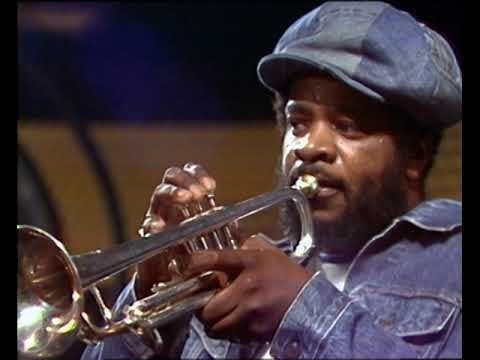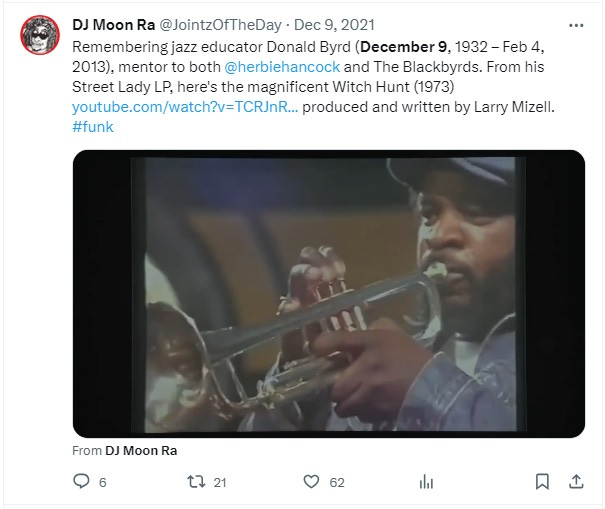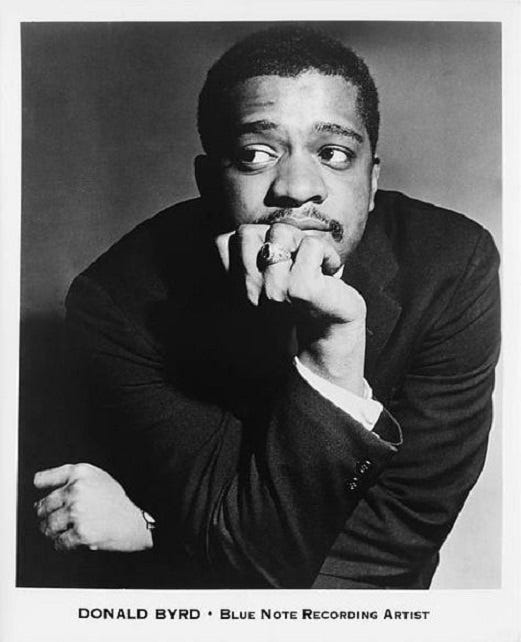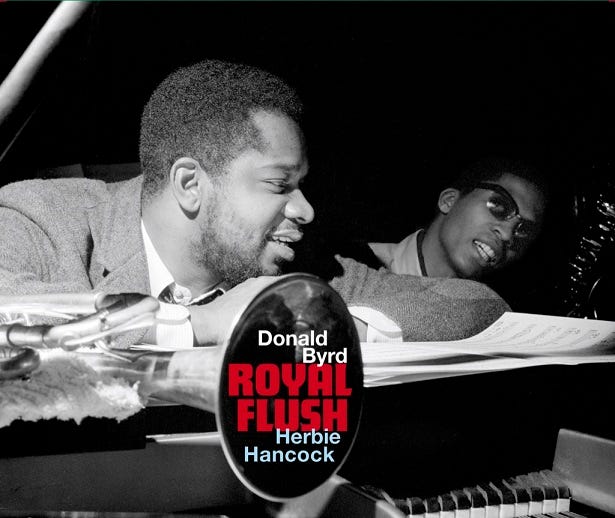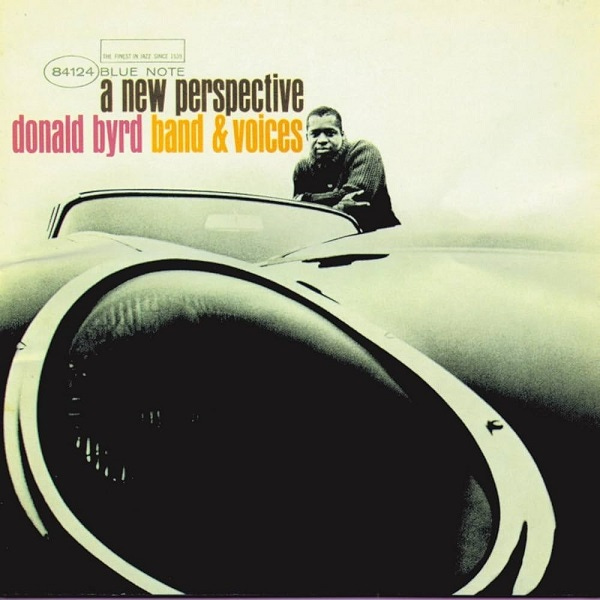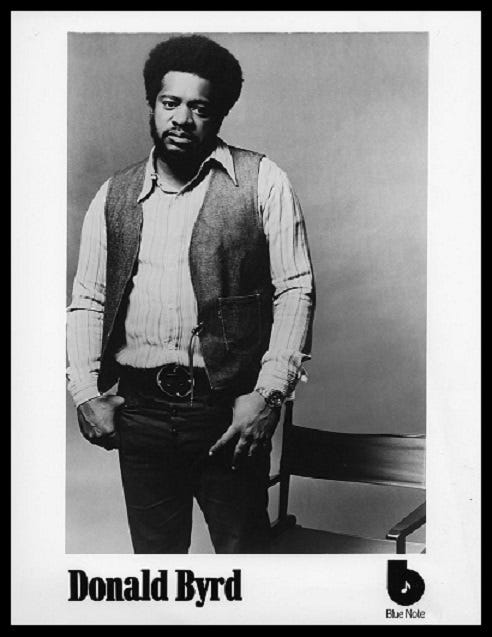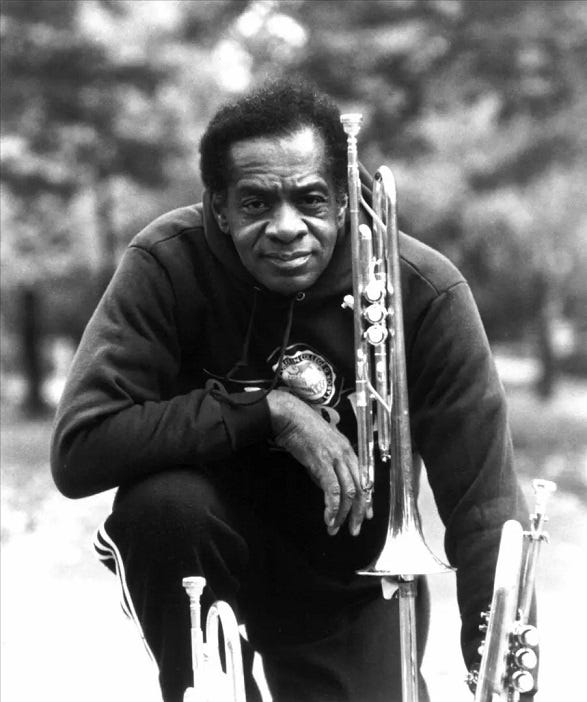Donald Byrd (December 9, 1932 – February 4, 2013) – Witch Hunt (1973)
The great jazz educator co-wrote this jazz-funk masterpiece for his Street Lady LP with producer Larry Mizell, the second of their classic Blue Note collaborations.
Watch full video on Twitter.
View most updated version of this post on Substack.
Open YouTube playlist of all songs in this post.
The trumpeter and musical genius Donald Byrd was Herbie Hancock’s mentor and helped his students at Howard University become the Blackbyrds in the early 1970s. When he taught at N.C. Central University in the early 80s, he and his students formed the 125th St NYC Band.
Donald Toussaint L'Ouverture Byrd II was born in Detroit. His father was a minister, his mother introduced him to jazz, and his uncle gave him his first trumpet at a young age. His first recording session was at Fortune Records’ makeshift Detroit studio in 1949. After studying music at Wayne State University, he moved to New York City and got his master’s degree from the Manhattan School of Music. Before graduating, in the mid-1950s he joined Art Blakey's Jazz Messengers, replacing Clifford Brown. Shortly afterwards, he appeared on albums by Jackie McLean and Mal Waldron.
In the 1960s, Byrd began teaching music at Howard University in D.C. while continuing to record and perform with the top jazz artists of the decade including John Coltrane, Sonny Rollins, and Thelonious Monk. He mentored many young jazz musicians, like Herbie Hancock, whose recording debut was on Byrd’s 1961 Blue Note album Royal Flush. He let Hancock share his Bronx apartment for several years, encouraged him to join Miles Davis’ quintet, and gave him valuable advice not to give away his music publishing rights.
In 1964, Byrd released his LP A New Perspective, in which he attempted to fuse jazz with gospel spirituals on superb tracks like “The Black Disciple,” which he wrote, and “Cristo Redentor,” written by the album’s arranger Duke Pearson. The LP featured a vocal choir that wordlessly accompanied the musicians, which included Hancock on piano, Kenny Burrell on guitar, Butch Warren on bass, and legend Hank Mobley on tenor sax. In its liner notes, Byrd explained the project’s intent:
“I mean this album seriously. Because of my own background [as the son of a Methodist minister], I've always wanted to write an entire album of spiritual-like pieces. The most accurate way I can describe what we were all trying to do is that this is a modern hymnal. In an earlier period, the New Orleans jazzmen would often play religious music for exactly what it was - but with their own jazz textures and techniques added. Now, as modern jazzmen, we're also approaching this tradition with respect and great pleasure.”
Starting with his 1969 album Fancy Free, Byrd began exploring the jazz-funk fusion he would soon perfect. Recorded that spring at Van Gelder Studio and released in December, it featured Pearson on electric piano, who also produced the LP. This marked the first time the instrument appeared on one of Byrd’s records. Byrd wrote its laid back title track, which opened the album, but saved the best for last with the stellar, funky closing cut “Weasil,” written by Charles Hendricks, with Lew Tabackin on flute, Julian Priester on trombone, and Joe Chambers on drums.
His next LP Electric Byrd was recorded on May 15, 1970 and came out that November, again produced by Pearson. As its title suggests, Byrd was competing with Miles’ recently released Bitches Brew (which hit stores in March, 1970) to see who could blaze the most groundbreaking fusion path.
Three of its four cuts were extended, spaced out, psychedelic-tinged jams, including the Brazilian-flavored “Xibaba,” written by percussionist Airto Moreira and featuring Hermeto Pascoal on flute. The LP’s closing cut was “The Dude,” with a funky Memphis soul sound underpinning the jazz improvisation of its players, who included Pearson on keyboards, Frank Foster on tenor sax, and Ron Carter on bass.
From August 25-26, 1971, Byrd recorded the tracks that would make up his next album Ethiopian Knights. Drew Pearson had left Blue Note earlier that year when its parent company Liberty Records was acquired by United Artists, and Ethiopian Knights was produced by United Artists A&R head George Butler and released in 1972. The same year, Butler would take over running Blue Note. He was instrumental in developing the label’s commercially successful run of classic jazz-funk albums of the seventies, and it all started with Donald Byrd.
It was the last truly transitional album for Byrd before his music became arguably more funk than jazz on the jazz-funk continuum, although its masterpiece was the very funky opening cut “The Emperor.” The LP’s all-star lineup included Jazz Crusaders Joe Sample on keyboards and Wilton Felder on electric bass, Bill Henderson III on electric piano, Bobbye Porter Hall on congas and tambourine, Ed Greene on drums, and Bobby Hutcherson on vibes.
Shortly after George Butler assumed control of Blue Note in early 1972, Byrd teamed up with two of his former Howard University music students, producers Larry and Fonce Mizell. Fonce had become a producer at Motown, one of the four members of The Corporation (along with their Howard classmate Freddie Perren, Deke Richards, and Berry Gordy) who wrote and produced all the Jackson 5’s early hits.
Larry Mizell wrote and produced his next album, with assistance from Fonce, which was recorded from April 3-4, 1972 at the Sound Factory in Hollywood. Black Byrd would prove to be Byrd’s breakthrough LP, becoming one of Blue Note’s all-time best selling albums when it was released in 1973. Its title inspired the name chosen by the group of his students he was mentoring at the time at Howard University when they signed with Fantasy Records the same year and became the Blackbyrds.
Every cut was golden, but its title track stood out, especially its exhortation to “Get in the groove and move!” He and his band memorably performed it live at the Montreux Jazz Festival in Switzerland on July 5, 1973, with Byrd and Fonce Mizell both on trumpet and vocals, plus Larry playing synthesizers, Allan Barnes on tenor sax and flute, Henry Franklin on electric bass, Barney Perry on guitar, and Keith Killgo behind the drums.
Other highlights were the very funky jam “Mr. Thomas,” the appropriately named, soaring jam “Sky High,” and the powerful message song that closed out the album, “Where Are We Going?” which was co-written by Larry Mizell and Larry Gordon. Its message for us remains all too relevant today:
“Day in, and day out…the air gets bad, the people shout...and day by day the flames get higher…lies and hate, they fuel the fire.”
Following the success of Black Byrd, Larry Mizell returned to produce and arrange Byrd’s next album Street Lady. Recording sessions took place from June 13–15, 1973, again at the Sound Factory, and the LP was released the following month. It was another classic jazz-funk set, with Fonce Mizell on clavinet, trumpet and vocals. One of its masterpieces was the magnificent jam “Witch Hunt,” which was co-written by Byrd and Larry Mizell.
They also co-wrote its superb opening cut “Lansana's Priestess,” and the fantastic jam “Sister Love.” Besides Byrd on trumpet and Fonce on keyboards, the album featured Roger Glenn on flute, David T. Walker on guitar, Chuck Rainey on electric bass, drummer Harvey Mason, King Errisson on congas and bongos, Stephanie Spruill on percussion, and Jerry Peters and Freddie Perren on additional keyboards.
When Byrd taught at North Carolina Central University in the early 80s, he and his students formed the 125th St NYC Band. They released the full-length album Love Byrd in September, 1981, which featured the superb jazz-funk-disco jam “Love Has Come Around.” Written by the group’s guitarist William Duckett and produced by Isaac Hayes, it was a dancefloor smash, hitting #4 on disco charts and reaching #15 R&B, Byrd’s highest-ever charting R&B single.
Byrd lived in Teaneck, New Jersey in the years before his death at age 80 in Dover, Delaware.
Happy Heavenly Birthday to the great Donald Byrd.
Further info:
“Donald Byrd, Jazz Trumpeter, Dies at 80,” obituary, The New York Times, February 11, 2013.
“Jazz is the Teacher: Donald Byrd's Lessons,” In Sheep's Clothing, September 30, 2020.
“The philosophy of the jazz trumpeter Donald Byrd,” HHV Magazine, February 2, 2023.
#jazz #funk #DonaldByrd


